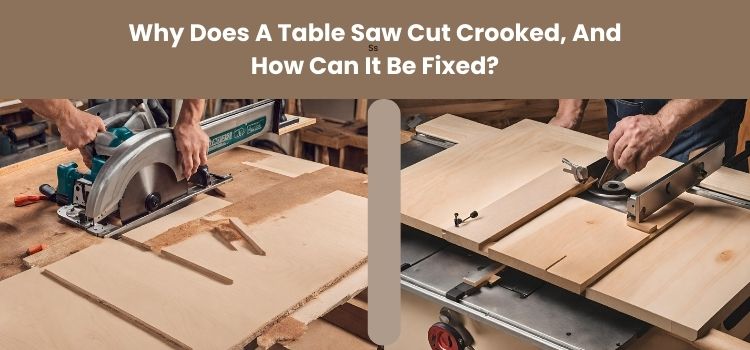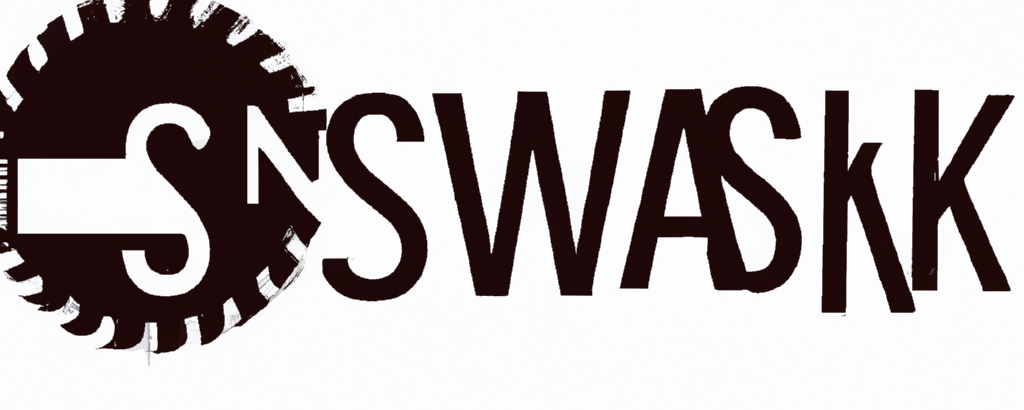Why Does A Table Saw Cut Crooked, And How Can It Be Fixed?

A clean, straight cut is essential for creating beautiful and functional projects. However, even the most experienced woodworkers can find themselves facing the frustration of crooked cuts from time to time.
There are a number of factors that can cause problems, including misaligned blades, worn or damaged blades, loose or misaligned fences, warped tables, and warped or misaligned saw carriages.
In this article, we will explore the top five reasons why a table saw cuts crooked and provide tips on how to fix and prevent these problems.
Top 5 Reasons for Table Saw Cut Crooked:
If your table saw cut crooked, here we have listed the top 5 reasons for you:
Reason 1: Misaligned Blade
A misaligned blade is one of the most common causes of crooked cuts on a table saw. This can happen for a number of reasons, such as misaligned fences, or a warped table.
When the blade is not perfectly aligned with the miter slots or the fence, it will cause the wood to be cut at an angle, resulting in a crooked cut. The amount of crookedness will depend on the degree of misalignment. Even a small misalignment can cause a significant error, especially on long cuts.
some examples of how a misaligned blade can cause crooked cuts:
- If the blade is not parallel to the fence, the cut will be angled away from the fence.
- If the blade is not perpendicular to the table, the cut will be angled down or up.
- If the blade is not centered in the miter slot, the cut will be angled to the side.
How to fix a misaligned blade:
To fix a misaligned blade, you need to check the alignment of the blade relative to the fence and the miter slots. There are a few different ways to do this, depending on your table saw.
One common method is to use a square. Place the square against the fence and the blade. The blade should be perfectly aligned with the square. If the blade is not aligned, adjust the arbor or the fence until it is.
Another method is to use a test cut. Make a cut in a piece of scrap wooCut is straight, the blade is aligned. If the cut is crooked, adjust the blade until it is aligned.
Once you have aligned the blade, make sure to check the alignment regularly. Misalignment can occur over time, especially if you are using the saw heavily.
Tips for preventing misaligned blades:
- Be careful not to bump or hit the blade.
- Check the alignment of the blade regularly.
- If you are using the saw heavily, consider checking the alignment of the blade before each use.
By following these tips, you can avoid making crooked cuts with your table saw.
Reason 2: Worn or Damaged Blade
A worn or damaged blade stands as another significant contributor to the dilemma of crooked cuts when using a table saw.
Over time and with regular use, blades can lose their sharpness, become dull, or sustain damage, such as becoming bent or warped. These imperfections in the blade alter its cutting dynamics, leading to imperfect, angled cuts.
some indications of how a worn or damaged blade can affect the quality of cuts:
- A dull blade may cause the wood to burn or splinter during the cut, compromising the finish.
- A bent or warped blade will lead to inconsistencies in the cut, making the wood veer off course or resulting in uneven depth along the length of the cut.
- The loss of blade teeth or uneven wear can result in a chattering cut, leaving a rough surface on the workpiece.
How to Address a Worn or Damaged Blade:
Rectifying issues arising from a worn or damaged blade primarily involves replacement or sharpening. Here’s how you can go about it:
- Inspect the blade regularly for signs of wear, damage, or dullness. If you notice any irregularities, consider replacing the blade with a new one that is sharp, straight, and appropriate for the material being cut.
- If the blade is dull but not damaged, you may opt to sharpen it using a blade sharpener, ensuring it regains its cutting efficiency. However, severely worn blades are typically better replaced than sharpened ones.
- After replacing or sharpening the blade, perform test cuts on scrap wood to verify the quality of the cut. If the amount is clean and straight, you’ve successfully addressed the blade issue.
Tips for Preventing Blade Wear and Damage:
- Use the appropriate blade for the material being cut. Hard materials can cause accelerated wear on blades designed for softer materials.
- Regularly clean the blade to prevent the buildup of sap and wood residue, which can contribute to dulling and uneven wear.
- Avoid cutting material with embedded nails, screws, or other foreign objects, as this can damage the blade teeth.
Reason 3: Loose or Misaligned Fence
The fence is a critical component of a table saw, as it guides the wood through the blade.
If the fence is loose or misaligned, it can cause the wood to veer off course, resulting in a crooked cut.
reasons why a fence might become loose or misaligned:
- Over time, the screws that hold the fence in place can loosen.
- The fence can be bumped or hit, which can cause it to misalign.
- The table saw itself can be warped or damaged, which can cause the fence to misalign.
Examples of how a loose or misaligned fence can cause crooked cuts:
- If the fence is loose, the wood can move while it is being cut, resulting in a crooked cut.
- If the fence is misaligned, the wood will not be guided through the blade at a straight angle, resulting in a crooked cut.
How to fix a loose or misaligned fence:
To fix a loose fence, simply tighten the screws that hold it in place.
To fix a misaligned fence, you will need to adjust the fence until it is parallel to the blade. You can use a square to check the alignment of the fence.
Tips for preventing a loose or misaligned fence:
- Make sure that the screws that hold the fence in place are always tight.
- Be careful not to bump or hit the fence.
- If you are using the saw heavily, consider checking the alignment of the fence regularly.
Reason 4: Warped Table
An uneven table surface can result in irregular cuts. This is because the wood will be cut at an angle if the table is not flat.
few reasons why a table saw table might become warped:
- Over time, the table can sag or warp due to its own weight.
- The table can be damaged by moisture or heat.
- The table can be warped if it is not properly supported.
Examples of how a warped table can cause crooked cuts:
- If the table is warped, the wood will be cut at an angle, resulting in a crooked cut.
- If the table is saggy, the wood will be cut at a different angle at the beginning and end of the cut, resulting in a crooked cut.
How to fix a warped table:
To fix a warped table, you will need to flatten the table surface. This can be done by sanding the table surface until it is flat or by using shims to level the table.
Tips for preventing a warped table:
- Make sure that the table is properly supported.
- Avoid exposing the table to moisture or heat.
- If you are using the saw heavily, consider checking the flatness of the table regularly.
Reason 5: Warped or Misaligned Saw Carriage
The saw carriage is the part of the table saw that holds and controls the blade’s movements. If the saw carriage is warped or misaligned, it can cause the blade to move in an erratic way, resulting in crooked cuts.
few reasons why a saw carriage might become warped or misaligned:
- Over time, the saw carriage can be damaged by heavy use or impact.
- The saw carriage can be misaligned due to improper maintenance or adjustment.
- The saw carriage itself can be warped or damaged due to defects in manufacturing.
Examples of how a warped or misaligned saw carriage can cause crooked cuts:
- If the saw carriage is warped, the blade will not move in a straight line, resulting in a crooked cut.
- If the saw carriage is misaligned, the blade will be angled at an angle, resulting in a crooked cut.
How to fix a warped or misaligned saw carriage:
To fix a warped or misaligned saw carriage, you will need to adjust the saw carriage so that it is straight and securely in place. This can be done by loosening the bolts that hold the saw carriage in place and adjusting it until it is straight.
If you are unable to adjust the saw carriage yourself, you may need to take the saw to a professional to have the saw carriage repaired or replaced.
Tips for preventing a warped or misaligned saw carriage:
- Avoid using the saw heavily.
- Maintain the saw regularly and adjust the saw carriage as needed.
- If you notice any problems with the saw carriage, have it repaired or replaced by a professional.
Conclusion
Crooked cuts from a table saw can be frustrating, but they are often preventable. By understanding the top five reasons why a table saw cuts crooked and following the tips provided in this article, you can ensure that your projects are always precise and professional.
additional tips to help you avoid crooked cuts:
- Use a sharp blade. A dull blade can cause the wood to burn or splinter, making it difficult to make a straight cut.
- Feed the wood slowly and evenly through the saw. This will help to prevent the wood from binding or kicking back.
- Keep the wood pressed against the fence. This will help to guide the wood through the saw in a straight line.
- Use a push block to help guide the wood through the saw. This is especially important for cutting small pieces of wood.
- Make sure the saw table is level. A warped or unlevel saw table can cause the wood to be cut at an angle.
FAQS:
Can table saws make angled cuts?
Yes, table saws have the capability to make angled cuts. By adjusting the blade’s tilt or using a miter gauge, a variety of angles can be achieved, allowing for versatility in woodworking projects.
Can a table saw do a 45 degree angle?
Absolutely, a table saw can cut at a 45-degree angle. Most table saws come with an adjustable blade angle feature. By setting the blade to a 45-degree tilt, one can achieve clean, precise angle cuts on the workpiece.
What saw is best for cutting angles in wood?
The best saw for cutting angles in wood is the miter saw. Designed specifically for this purpose, it allows for precise angle adjustments and delivers clean, accurate angled cuts, making it a favorite for trim work and framing.
What saw is used for cutting straight accurate lines in wood?
The table saw stands out as the premier tool for cutting straight, accurate lines in wood. With a stable platform and a straight fence, it ensures that each cut is clean, straight, and consistent, vital for many woodworking tasks.
How do you cut odd angles?
To cut odd angles, first measure and mark the desired angle using a protractor or angle finder. Transfer this mark to your wood. Use a miter saw, set to the specific angle, or a handsaw with careful guidance to make the cut.
